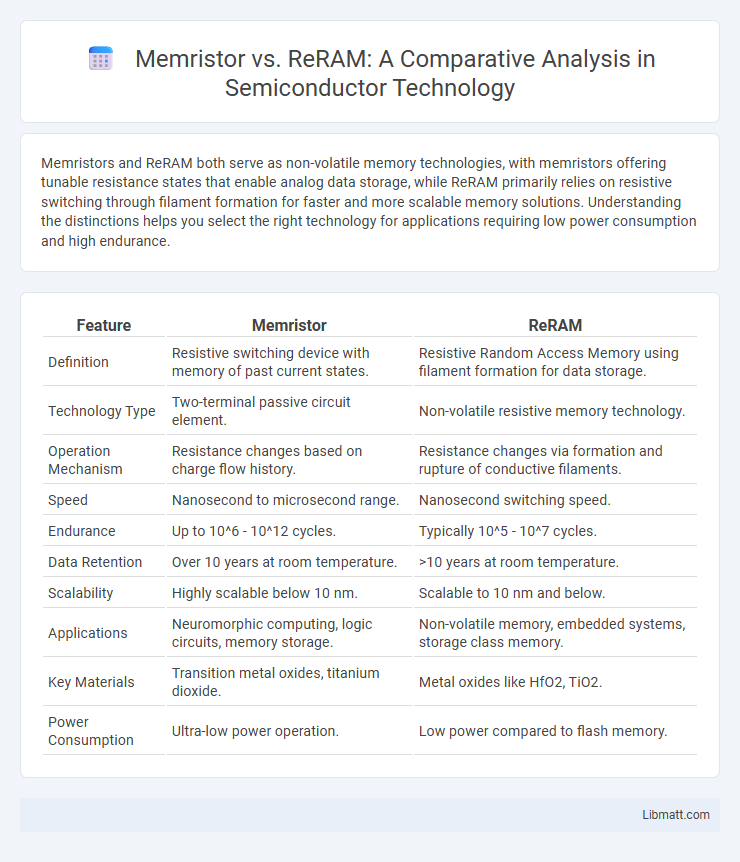Memristors and ReRAM both serve as non-volatile memory technologies, with memristors offering tunable resistance states that enable analog data storage, while ReRAM primarily relies on resistive switching through filament formation for faster and more scalable memory solutions. Understanding the distinctions helps you select the right technology for applications requiring low power consumption and high endurance.
Table of Comparison
| Feature | Memristor | ReRAM |
|---|---|---|
| Definition | Resistive switching device with memory of past current states. | Resistive Random Access Memory using filament formation for data storage. |
| Technology Type | Two-terminal passive circuit element. | Non-volatile resistive memory technology. |
| Operation Mechanism | Resistance changes based on charge flow history. | Resistance changes via formation and rupture of conductive filaments. |
| Speed | Nanosecond to microsecond range. | Nanosecond switching speed. |
| Endurance | Up to 10^6 - 10^12 cycles. | Typically 10^5 - 10^7 cycles. |
| Data Retention | Over 10 years at room temperature. | >10 years at room temperature. |
| Scalability | Highly scalable below 10 nm. | Scalable to 10 nm and below. |
| Applications | Neuromorphic computing, logic circuits, memory storage. | Non-volatile memory, embedded systems, storage class memory. |
| Key Materials | Transition metal oxides, titanium dioxide. | Metal oxides like HfO2, TiO2. |
| Power Consumption | Ultra-low power operation. | Low power compared to flash memory. |
Introduction to Memristor and ReRAM Technologies
Memristors are non-volatile memory devices that regulate electrical resistance based on the history of voltage and current, enabling efficient data storage with low power consumption. Resistive Random Access Memory (ReRAM) operates by altering the resistance of a dielectric solid-state material to store data, offering high speed, scalability, and endurance. Both technologies represent promising advances in next-generation memory, with memristors emphasizing analog computing capabilities and ReRAM focusing on digital storage applications.
Historical Background and Evolution
Memristors, conceptualized in 1971 by Leon Chua as the fourth fundamental circuit element, experienced practical realization only in the late 2000s, revolutionizing non-volatile memory technology by enabling state-dependent resistance. ReRAM (Resistive Random Access Memory), emerging prominently in the 2000s, leverages resistive switching mechanisms to store data, drawing on memristor principles but focusing on material-based resistance changes, such as in metal oxides. Both technologies have evolved through advancements in nanofabrication and materials science, substantially impacting next-generation memory architectures with their potential for high speed, low power consumption, and scalability.
Understanding the Working Principles
Memristors operate by changing resistance based on the history of voltage and current, enabling non-volatile memory storage through variable resistance states. ReRAM (Resistive Random Access Memory) functions by forming and rupturing conductive filaments within a dielectric material, which alters resistance to store data persistently. Understanding these working principles highlights how your device can leverage memristor's analog resistance or ReRAM's filamentary switching for efficient data retention and processing.
Key Material Differences
Memristors primarily utilize metal oxides such as titanium dioxide (TiO2) for their resistive switching properties, while ReRAM (Resistive Random-Access Memory) often employs a wider range of metal oxides including hafnium oxide (HfO2) and tantalum oxide (Ta2O5). The switching mechanism in memristors is based on the migration of oxygen vacancies or metal ions, which alters the device's resistance state, whereas ReRAM relies on the formation and rupture of conductive filaments within the oxide layer. Understanding these key material differences enables you to select the appropriate technology based on endurance, switching speed, and scalability requirements.
Performance Comparison: Speed, Endurance, and Retention
Memristors typically offer faster switching speeds, reaching nanosecond range, compared to ReRAM, which operates in microseconds to nanoseconds, enhancing your device's responsiveness. In terms of endurance, memristors can sustain up to 10^12 write cycles, surpassing many ReRAM variants that range between 10^6 to 10^9 cycles, making them more durable for intensive applications. Data retention in memristors can exceed 10 years under normal conditions, rivaling ReRAM's retention capabilities that also ensure long-term stability in various environments.
Advantages and Limitations of Memristors
Memristors offer advantages such as non-volatility, high switching speed, and low power consumption, making them ideal for memory storage and neuromorphic computing applications. However, challenges include device variability, limited endurance, and difficulties in large-scale fabrication. These limitations impact their commercial viability compared to ReRAM, which currently provides more mature technology with better consistency.
Advantages and Limitations of ReRAM
ReRAM offers advantages such as high-speed switching, low power consumption, and excellent scalability for non-volatile memory applications. Its ability to endure more than 10^12 write/erase cycles surpasses many traditional memory technologies, providing enhanced durability. Limitations include variability in switching behavior, endurance degradation under high-temperature conditions, and challenges in integrating with existing CMOS processes.
Applications in Modern Computing
Memristors and ReRAM are pivotal in modern computing for enhancing non-volatile memory performance and enabling neuromorphic architectures that mimic neural networks. Memristors offer ultra-fast switching speeds and low power consumption, making them ideal for in-memory computing and AI accelerators. ReRAM provides high endurance and scalability, supporting applications in data storage, embedded systems, and edge computing devices where efficiency and reliability are critical.
Future Prospects and Research Directions
Memristor and ReRAM technologies both exhibit promising future prospects in non-volatile memory and neuromorphic computing, with research increasingly focusing on enhancing scalability, endurance, and switching speed. Advanced material engineering and device architecture optimization aim to overcome challenges like variability and retention in memristors, while ReRAM development emphasizes lower power consumption and multi-level cell capabilities. Emerging research directions include integrating these memories into AI hardware accelerators and exploring hybrid systems that combine memristor and ReRAM advantages for optimized performance.
Conclusion: Which Suits Your Needs?
Memristors offer faster switching speeds and higher endurance, making them ideal for applications requiring rapid data access and frequent write cycles. ReRAM provides better scalability and lower power consumption, suitable for energy-efficient memory storage in mobile and edge devices. Assess your specific performance, power, and capacity requirements to determine whether Memristor or ReRAM technology aligns best with your project's goals.
Memristor vs ReRAM Infographic

 libmatt.com
libmatt.com